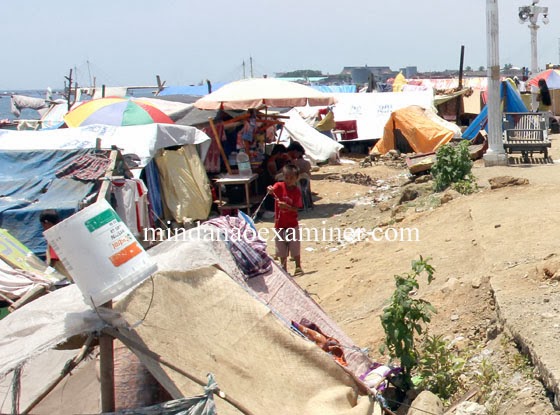
ZAMBOANGA CITY – Today, four months on from an attack by rebels, more than 59,000 people are still displaced in Zamboanga City on the southern Philippine island of Mindanao, the United Nation’s Office for the Coordination of Humanitarian Affairs said.
They are living in the 10 remaining evacuation centres scattered across the port city. They are living in overcrowded conditions and have limited access to basic sanitation facilities, it said.
Putli Suhaili, 45, a widowed mother of five lives at the city’s sports stadium that was turned into an evacuation centre in the days after the fighting began. She feels that her family has been forgotten.
“We are having a very difficult time,” she says. “There is not enough food and water, and our kids are dying in these conditions. I have nowhere to go.”
Destroyed homes and ruined livelihoods
Between early September and mid-December, forty-seven deaths were reported at the stadium evacuation center, almost half of them children below five years old and most of them resulting from inadequate access to clean water and sanitation. More than 20,000 people are vulnerable to disease outbreaks.
“The camps are very crowded, living conditions are not healthy,” said Safia Crisostomo, a Camp Manager for the Department of Social Welfare and Development, the government agency leading the humanitarian response. “One of our major concerns is child health related to waterborne diseases. Some expansion in water and sanitation activities, like clean water and latrines could improve the situation.”
Healthcare, emergency shelter and protection are also priorities, say aid groups.
Many families say they cannot return to their homes because they were destroyed or because their livelihoods were lost. Boging Gamilay, is a fishermen from Mariki, a village outside Zamboanga. His house was destroyed and his boat and nets were burned. He is now living in an informal camp just outside the stadium.
“Living conditions are not good here but we have nowhere to go back too. My boat, house and livelihood…everything is gone now.”
More than $70 million in damages
The fighting between a faction of the Moro National Liberation Front (MNLF) and Government forces left over 200 people dead, with roughly 128,000 people affected in Zamboanga and on the nearby island of Basilian. Heavy fighting brought Zamboanga – a city of nearly 1 million – to a standstill. Over 10 per cent of the city’s population was displaced.
An estimated 46,000 jobs were lost or disrupted due to the conflict and more than 6,600 homes completely destroyed by fire. The total damage is estimated at US$73.2 million according to the Government.
The situation worsened in October when days of heavy rains triggered flooding across the city, submerging some evacuation centres and increasing health risks for people living in them.
Decongestion of largest evacuation centres a priority
The Government and humanitarian community are now working to decongest some of the largest evacuation centres as well as schools that have been used as places of refuge. The larger ones pose increasing health risks, say government officials. Efforts are already underway to move the 3,700 people from seven schools to transitory sites so children can return to classes.
However broader relocation efforts have been delayed by a lack of appropriate sites.
In the longer-term, the Government and aid agencies will support communities to rebuild homes, restore livelihoods and repair schools. They will also prioritize counselling services for the thousands who have been traumatized by the events of the past four months.
A slow response from donors
In late December the Government announced the Zamboanga City Roadmap to Recovery and Reconstruction, a plan that will provide more than 7,200 families with longer-term support. However funding is urgently needed to meet short-term needs.
OCHA has issued repeated calls for support for this “forgotten” crisis. However, only $6.1 million has been contributed to the international community’s $24.4 million appeal. This appeal covers activities up to March 2014.
Some aid workers are warning that there is only a short window of time to provide people with the assistance they need. “The risk of further disease outbreaks is alarming as the sanitation and health conditions in the camps are insufficient”, said Sharon Pacaldo, a Philippines Red Cross nurse.
“Urgent funding is needed to ensure these people have access to sufficient food, clean water, sanitation, shelter and livelihoods as well as to provide tools and equipment to enable them to rebuild their lives and homes”, said the United Nations Deputy Humanitarian Coordinator Chris Kaye.
“There is a need to start the process of rehabilitating or reconstructing schools and houses in the conflict zones, to install water and sanitation facilities and re-start long-term livelihood activities,” continued Mr. Kaye. “It is time to place some attention on this forgotten emergency to ensure these people receive the continued assistance they require.”
OCHA is the part of the United Nations Secretariat responsible for bringing together humanitarian actors to ensure a coherent response to emergencies. It also ensures there is a framework within which each actor can contribute to the overall response effort.
Link: http://www.unocha.org/top-stories/all-stories/philippines-zamboanga-forgotten-crisis-shadow-haiyan#.Usn3NqxYquw.facebook

